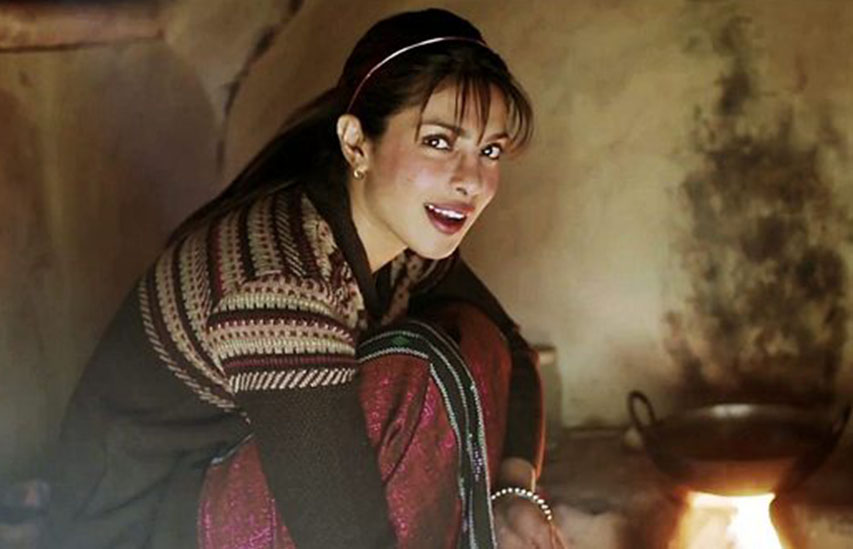
True Review: Mary Kom
by Niharika Puri September 5 2014, 10:16 am Estimated Reading Time: 4 mins, 57 secsCritics Rating: 3 Stars*
Cast: Priyanka Chopra, Sunil Thapa, Darshan Kumar,
Direction: Omung Kumar
Produced: Viacom 18 Motion Pictures, Sanjay Leela Bhansali.
Written: Karan Singh Rathore, Ramendra Vasishth
Genre: Biopic
Duration: 2 Hrs 3 Mins
This reviewer shall confess at the very outset that she has not read Mary Kom’s autobiography Unbreakable. The title of the book certainly sums up her spirit in life and also in the film, though it is replete with some sizeable leaps from reality. Even though the film is not an adaptation of the Harper Collins publication, it is not difficult to see the extensive liberties taken with the national champion’s story.
Mangte Chungneijang Mary Kom, a farmer’s daughter is a plucky, bright-eyed youngster from Kangathei, Manipur. Her aggression seems wrongfully mangled into some serious rage issues in the script, but we can ignore the volatility for the larger purpose of the plot. Coach Narjit Singh (Sunil Thapa) takes her under his wings, training her in the dusty, dimly-lit gym, which has the inspirational poster, “Believe you can and you are halfway there”, condensing the overall message of the film.
Her ‘Coach sir’ is no softie and believes, rightfully so, that mercy is unwarranted in the ring. “Dayaa nurse karega aur ilaaj doctor,” he says dismissively. Her rigorous regime grooms Mary into a fierce pugilist, who goes on to win scores of medals, while also abbreviating her name to the more accessible MC Mary Kom.
There is also a romantic track of Mary and K Onler Kom (Darshan Kumar), which has its share of endearing moments, if it was not for the slightly stilted chemistry between the two actors. The second half features the heroine coping with domesticity, marital life and an even more severe fitness schedule to get in top form for the big game.

But we move onward to the critique now. The real-life MC Mary Kom is a diminutive figure, standing at 5 feet 2 inches. It makes her feats all the more impressive and her blows all the more lethal. Priyanka Chopra, who is a good four inches taller, makes for a more imposing screen presence. Height aside, it would be wrong to dismiss her as poor casting choice.
Clearly a woman-centric project needed a saleable star. Unfortunate, but true. This reviewer would have personally preferred a Manipuri import, but that is apparently not as commercially viable an option. It does not, in any way, take away from a good performance.
Our leading lady also does what she can to capture Ms. Kom’s Hindi diction. It gets a little uneven but she holds on. This is why the appearance of a Manipuri lady doctor in two scenes, speaking with a clear Hindi accent, rankles audibly.
What are more jarring are the unintelligent, poorly inserted brand placements. It diminishes the seriousness of an icon’s life. Does Ms. Kom really use a particular brand of salt in her cooking? Would she really have swatted away Onler’s arm, insisting that she preferred a certain brand of artificial sweetener over sugar? Did the Koms really show a partiality for a particular relieving balm to soothe aches? These little touches deprive the film of its more human nuances, making it appear as a cash-grabbing vehicle for all involved, rather than a tribute.
For if this film was really meant to be a salute to Ms. Kom’s life, they would have wanted to stay closer to her life’s details instead of creating their own moments, which seem shaky in places. In a scene where Ms. Chopra flings a chair at judges for losing a match to a younger player, she thunders, “India mere heart mein hai!” This affirmation comes out of nowhere, considering that not once in the film is a racial or communal remark passed against North-East Indians.

The slimy Sharmaji is the oft-stereotyped government bureaucrat who brings down the film with his loud declaration of getting Mary to quit boxing. It would have been better if the state of Indian athletes was portrayed as a systemic failure instead of one babu being his sleazy self.
The following important character details have not been included.
Mary, in real life, had met Onler in Delhi University in 2001, not in an underground fighting racket. Onler, unlike portrayed in the film, was a law student at DU and president of the Kom student community. This fact, if incorporated in the film, would have made him a strong counterpart and support to Mary, instead of being a one-dimensional stay-at-home dad. Theirs was a tender romance, the sweet details omitted from the story.
Where Mary’s father was against her playing the violent sport, Onler’s father was one of her biggest supporters. He was shot dead by militants in 2006, which was a devastating personal setback for the couple.
Ms. Kom’s bronze win at the Olympics is not depicted but mentioned in passing via rushed title cards, even though that was a triumph that earned her nationwide recognition. It is only after this victory that the state government had allotted three acres of land to her so that she could set up a training academy for aspiring young fighters.
Despite the acclaim, the Koms lack infrastructure and are only able to house learners from within Manipur, training them for free. This nugget of information is unacknowledged before the end credits roll. For a film that will be making its box office monies from a humble sportsperson’s life, it is a matter of great disservice not to mention her training school.
Despite the factual departures, Mary Kom the film works as an entertainer. It seems less of a biopic and more of a dramatised, fictionalised sports film for the makers concerned, but it is certainly worth a (tax-free) watch. It has enough pace, intensity and whistle-worthy moments to keep you engaged.






-173X130.jpg)

-173X130.jpg)


-173X130.jpg)

-173X130.jpg)